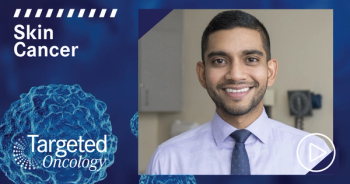
Systemic Treatment for Advanced Non-Melanoma Skin Cancer
Shubham Pant, MD:When you see a patient who has advanced or metastatic basal cell or squamous cell carcinoma, and I’ll go with basal cell first, what are the treatment options for these patients?
Michael R. Migden, MD:In basal cell carcinoma, and it’s pretty much the same for squamous cell carcinoma, 95%-plus of the tumors are treated with a local therapy that could be surgery, such as Mohs surgery or excision. It could be, if it’s a smaller lesion, destruction with curettage and either electrodesiccation or cryotherapy. Some of these can be treated, if they’re extremely thin, with topical agents such as imiquimod. That would be, for example, superficial basal cell carcinoma.
Shubham Pant, MD:What are the primary treatment options for locally advanced or metastatic squamous cell carcinoma?
Michael R. Migden, MD:The history of treatment for locally advanced or metastatic squamous cell carcinoma has been that there’s no one standard of therapy. There’s been chemotherapy such as platinum agents. There have been epidermal growth factor receptor targeted agents. But there’s not been one standard, and there’s really never been until recently an FDA approved treatment, a systemic therapy, and that’s changed recently.
Shubham Pant, MD:I’ll come to that, but tell me a little bit about what kind of targets can you find. What changes, somatic mutations, are found? Is there something like EGFR? In basal cell, we know Hedgehog inhibitors work very well. Could you comment on what targeted therapy has been employed in clinical trials, what has been successful, and what are we looking for down the line?
Michael R. Migden, MD:Right, as you said, for basal cell carcinoma, there are Hedgehog inhibitors, which to date have been primarily focused on smoothened inhibitors. There are newer agents coming, and we could discuss that. For squamous cell carcinoma, there are epidermal growth factor receptor inhibitors, and there are multiple of them. And then one newer agent being investigated is targeted to casein kinase 2 [CK2], and casein kinase 2 targeted agents work in 3 different areas. They work to decrease phosphorylation of smoothened. They work to decrease stabilization of glioma in the nucleus, and they also work on the noncanonical Wnt pathway, which is a pathway that often results in persistent tumor rather than typical resistance where the tumor is growing but the tumor can persist.
So this CX-4945 agent, which is a CK2 inhibitor, works in all 3 areas. And that’s exciting because the typical Hedgehog inhibitors work at smoothened, and there’s a fair number of points where resistance can develop in the…drug binding pockets for different agents, which can be a problem. So this works downstream from that, and the further downstream in the Hedgehog pathway you work, the more likely that you can decrease resistance developing.
Shubham Pant, MD:So you’re thinking about these agents for people who would be resistant to the Hedgehog inhibitors, or do you think they could be combined with Hedgehog inhibitors later?
Michael R. Migden, MD:Well, there’s always a potential to combine. These Hedgehog inhibitors, the released ones, the approved ones are smoothen inhibitors. So there’s always a possibility to have a combination. Currently, it’s being studied in people who were either failing a Hedgehog inhibitor or couldn’t tolerate one because Hedgehog inhibitors have some adverse events that are difficult to tolerate. It’s not that there’s many life-threatening events, it’s just that it’s hard for the patient to stay on because of the bothersome nature of these month after month without drug holidays. There are some recent studies in the last year fromNatureand fromCancer Celltalking about these noncanonical pathways. They can result in persistent tumor, so tumor that has low cell cycling metabolism. It doesn’t really grow. It just doesn’t go away, and then as soon as you stop the Hedgehog inhibitor it will grow, and those are challenges.
Shubham Pant, MD:It’s almost like you’ve got the foot on the neck of the cancer, but if you remove the foot, it starts growing.
Michael R. Migden, MD:Right.
Shubham Pant, MD:And I think you mentioned a very important thing in targeted therapy. It’s not just the first month when we look at the maximal tolerated dose, it’s the chronic dosing, which can end up being an issue with patients. So normally, when you’re giving the Hedgehog inhibitors, do you do a stop and go? What’s your normal approach?
Michael R. Migden, MD:Well, it’s interesting. There was a previous study that talked about intermittent dosing, and they didn’t, in that study, find that resistance was an issue. But the newer papers from 2018, the 2Naturepapers and theCancer Cellpaper, pretty much all comment that because these noncanonical pathways, both Wnt and Notch, can leave these slower cycling persistent cells, as well as the PI3K/mTOR pathway that can cross-talk over to the Hedgehog pathway and actually produce some growth, that any amount of drug holiday is a set up for the tumor to start growing. And so the takeaway trying to reconcile those 2, which have different opinions, is that yes, some patients need drug holidays. But you should think twice and only use drug holidays when they just have to be used.
Because I did a lot of the research with clinical trials and Hedgehog inhibitors, sometimes patients say, “Well, you told me I could take a drug holiday, but I’m going to take my drug holidays myself when I feel like it in the future,” because they’re not afraid that something could happen. But based on this newer literature, I would caution patients to take them when necessary, but certainly don’t take them on some regular frequency until this is reconciled.
Shubham Pant, MD:And always with the advice of your doctor.
Michael R. Migden, MD:Absolutely. And let the prescriber know what you’re doing.
Transcript edited for clarity.








































